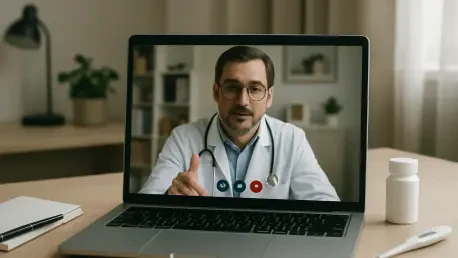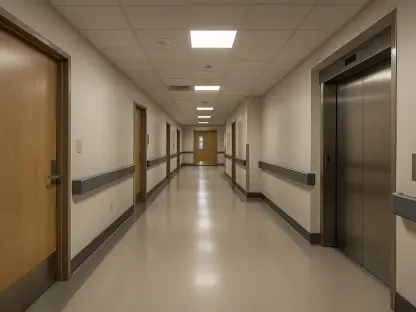In the high-pressure world of emergency response, where split-second decisions can mean the difference between life and death, Augmented Reality (AR) is emerging as a groundbreaking tool for medical training through telemedicine. This technology is reshaping how first responders, such as paramedics and emergency medical technicians, prepare for the unpredictable challenges they face daily. By offering immersive simulations that mirror real-life crises, AR equips these professionals with the skills and confidence needed to act decisively in critical moments. As the healthcare sector increasingly turns to digital solutions to address training gaps, AR stands out for its ability to provide realistic, accessible, and scalable learning experiences that directly improve patient outcomes.
The global market for AR in telemedicine training tailored for first responders is experiencing remarkable growth, with projections estimating an increase from USD 1.4 billion currently to USD 4.2 billion by 2035, driven by a robust Compound Annual Growth Rate (CAGR) of 11.8%. This surge reflects a broader trend in healthcare toward integrating technology to enhance efficiency and effectiveness. Beyond mere numbers, the real impact lies in how AR bridges the divide between theoretical knowledge and practical application, ensuring that emergency personnel are not just trained but truly prepared for the chaos of real-world scenarios. This transformative approach is becoming indispensable as the demand for skilled responders continues to rise globally.
Revolutionizing Emergency Preparedness
Building Mastery Through Simulation
AR technology is fundamentally changing the landscape of first responder training by creating virtual environments that replicate the intensity and complexity of actual emergencies. Trainees can engage in scenarios ranging from car accident trauma to natural disaster response, practicing intricate procedures without any risk to real patients. This immersive method allows for repeated exposure to high-stakes situations, fostering muscle memory and sharpening critical thinking under pressure. The result is a workforce better equipped to handle the unpredictable nature of their roles, where hesitation or error can have dire consequences. Moreover, the ability to simulate rare but critical events ensures that responders are ready for even the most uncommon challenges they might encounter in the field.
Unlike traditional training, which often relies on static mannequins or limited role-playing, AR offers a dynamic and interactive platform that adapts to the trainee’s actions in real time. This responsiveness means that each decision made during a simulation can alter the outcome, providing immediate feedback on performance and areas for improvement. Such tailored learning experiences are invaluable for building confidence, as they allow first responders to see the direct impact of their choices in a controlled setting. Additionally, the technology supports a wide range of emergency contexts, ensuring that skills are not only developed but also retained through consistent, realistic practice. This depth of preparation is setting a new standard for what it means to be ready for emergency medical response.
Enabling Access Across Distances
One of the most significant advantages of AR in telemedicine training is its capacity to deliver high-quality education regardless of geographic location. First responders in rural or remote areas, often far from training centers, can now access sophisticated simulations through devices like smart glasses or mobile systems. This eliminates the logistical hurdles and costs associated with travel or centralized facilities, making top-tier training available to a broader audience. For regions where healthcare resources are scarce, this accessibility can transform the capabilities of local emergency teams, ensuring they are just as prepared as their urban counterparts to save lives.
Beyond simply reaching isolated areas, AR facilitates real-time collaboration with experts who can guide trainees through complex scenarios from anywhere in the world. This telemedicine integration means that a seasoned specialist in a major city can mentor a responder in a small town during a simulated disaster response, offering insights and corrections as the situation unfolds. Such connectivity not only enhances the learning process but also builds a network of support that can extend into actual emergencies. By breaking down barriers of distance, AR ensures that expertise is shared widely, creating a more uniformly skilled global workforce of first responders ready to tackle any crisis with informed precision.
Key Catalysts and Market Insights
Advancements Fueling Practical Solutions
The rapid evolution of AR technology is a primary force behind its growing adoption in first responder medical training. Innovations in hardware, such as lightweight head-mounted displays, and software that enhances the realism of simulations are making training more effective and engaging. When combined with complementary technologies like Virtual Reality (VR) and Mixed Reality (MR), AR creates comprehensive environments that mimic everything from battlefield injuries to urban medical emergencies. These advancements allow for nuanced learning experiences where trainees can practice specific skills repeatedly until mastery is achieved, all without the ethical or safety concerns of real-life practice.
Equally important is the cost-effectiveness that AR brings to the table, a factor that resonates deeply with budget-constrained emergency services and healthcare organizations. Traditional training methods often require expensive physical setups, dedicated spaces, and frequent travel for in-person sessions, all of which strain resources. In contrast, AR reduces these expenses by enabling digital simulations that can be accessed on-demand through widely available devices. This scalability means that a single investment in AR technology can train countless responders over time, offering a sustainable solution that aligns with the financial realities of many agencies. As a result, the technology is becoming a preferred choice for modernizing training programs worldwide.
Tackling Broader Healthcare Needs
AR’s role in first responder training is a critical piece of the larger puzzle of digital transformation within healthcare, addressing systemic challenges like unequal access to education and care. In many parts of the world, particularly in underserved or developing regions, the lack of trained personnel can exacerbate emergency situations, leading to poorer outcomes. AR steps in by providing customizable simulations that prepare responders for the specific types of crises they are most likely to face, whether urban trauma or rural health emergencies. This targeted approach ensures that training is relevant and directly applicable to local needs.
Furthermore, the technology supports a shift toward patient-centered care by prioritizing outcomes over mere procedural knowledge. Simulations can be designed to emphasize not just technical skills but also communication, teamwork, and empathy—elements that are crucial in high-stress emergency settings. By integrating these softer skills into training, AR helps create responders who are not only competent but also compassionate, enhancing the overall quality of care delivered. As healthcare systems globally grapple with increasing demands and limited resources, AR offers a forward-thinking solution that scales with need, ensuring that first responders are a reliable first line of defense in any crisis scenario.
Global Adoption and Future Horizons
Established Markets and Rising Regions
The adoption of AR for telemedicine training among first responders reveals a varied global landscape, with distinct leaders and emerging players shaping the market. North America stands at the forefront, bolstered by a robust technological infrastructure and the presence of industry giants driving innovation in AR applications. Europe follows closely, with countries like Germany and the UK making substantial investments to modernize healthcare training through digital tools. These regions benefit from strong regulatory frameworks and funding that facilitate the integration of AR into emergency response systems, setting a benchmark for others to follow.
Meanwhile, the Asia-Pacific region is witnessing accelerated growth, fueled by the urgent need for cost-effective training solutions in densely populated and rapidly developing nations like China and India. Here, AR addresses the challenge of training large numbers of responders across vast and diverse terrains, often with limited access to traditional resources. South America and the Middle East & Africa, though slower to adopt, are beginning to recognize the potential of AR, with early initiatives signaling untapped opportunities. As awareness spreads and infrastructure improves, these regions could become significant markets, offering long-term prospects for stakeholders willing to invest in localized solutions.
Strategic Alliances and Tailored Innovations
Collaboration between technology providers and healthcare entities is proving to be a cornerstone of AR’s success in transforming first responder training. These partnerships are essential for developing solutions that are not only cutting-edge but also practical, meeting the specific demands of emergency agencies. By working closely with responders and medical professionals, tech companies can create simulations that reflect real-world challenges, ensuring relevance and effectiveness. Such alliances also help navigate the complexities of regulatory compliance, making AR a trusted tool in critical training programs.
The competitive environment is further enriched by a focus on innovation, with global leaders integrating advanced features like artificial intelligence (AI) to personalize learning experiences. AI can analyze a trainee’s performance in simulations and adapt scenarios to address weaknesses, creating a customized training journey. Additionally, the emphasis on wearable devices for real-time feedback during exercises enhances the learning curve, providing immediate insights that refine skills on the spot. These tailored innovations, supported by strategic partnerships, ensure that AR remains at the forefront of emergency training, continuously evolving to meet the dynamic needs of first responders across the globe.
Reflecting on Progress and Next Steps
Lessons from a Digital Shift
Looking back, the integration of AR into first responder medical training marked a pivotal moment in how emergency preparedness was approached. The technology proved its worth by offering simulations that mirrored the chaos of real emergencies, allowing trainees to build skills and confidence in a controlled environment. Its ability to deliver remote access and real-time expert guidance broke down longstanding barriers, ensuring that even the most isolated responders had the tools to excel. Reflecting on this journey, the impact on patient outcomes became evident, as better-trained personnel translated into faster, more accurate responses during crises.
Charting the Path Forward
As the landscape of emergency response continues to evolve, the next steps for AR in telemedicine training involve deeper integration and broader reach. Stakeholders should prioritize expanding access in emerging markets, tailoring solutions to local challenges to maximize impact. Investment in research and development will be crucial to refine simulations and incorporate emerging technologies like AI for even more personalized training. Additionally, fostering global collaboration among tech innovators, healthcare providers, and government bodies can standardize best practices, ensuring that AR’s benefits are felt universally. By focusing on these actionable strategies, the future of emergency training can build on past successes to create a more resilient and responsive healthcare system.









